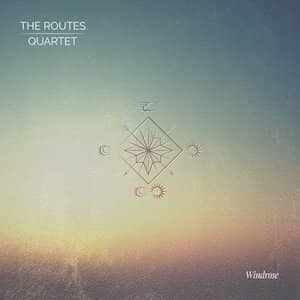 Routes Quartet – Windrose
Routes Quartet – Windrose
Routes Records – 2017
Listen to ‘Windrose’, and it soon becomes clear that the Routes Quartet are not your average string outfit. Comprised of Rufus Huggan (cello), Emma Tomlinson (viola), Gràinne Brady and Tricia Mullan (fiddles), they may have the structure of a classical quartet, but they seek to infuse everything with an ounce of folk. This is partly due to the firmly traditional roots of some of some of the members. Grainne Brady, in particular, was taught by her father and developed her style through playing folk sessions with her family, and Tricia Mullan also studied both traditional and classical music. Tackling their folk repertoire with a string quartet setup might seem a brave move, as it’s well known that there can be pitfalls to approaching a traditional tune with a rigid classical mindset. Stick slavishly to the technique of the thing, and the tune becomes a lifeless husk. Sure, you’re playing what’s on the page, but all spirit has long since departed. The Routes Quartet avoid this by composing almost everything themselves, with largely universal success.
The album begins with Roisín and Paddy, a tune with a wonderfully clever opening which seems to symbolise the quartet’s approach to genre-bending. A full-bodied yet restrained chord might remind you of the start of a classical chamber piece until your brain is wrong-footed by insistent strings and a delightful and atmospheric layering of rhythm. Waves of sound weave in intriguing ways to create a set which lies somewhere between a folk standard and modern classical, and this is a stylistic choice which continues throughout the album. A cinematic approach is shown in Kathryn Tickell’s Fenham, where a melancholy but arresting start from the viola hooks the listener in immediately, balanced by some beautiful sustained notes from the rest of the group. The layers are built up in echoing waves, and the tune that results is something powerful, lyrical, and achingly beautiful, seemingly crying out to be used in the score of a period drama.
A sense of epic scale is evident in much of the album, including Gentleman’s Farewell from fiddler Tricia Murray, which conjures up images of vast open hillsides and bittersweet partings with great vitality. Retreat Marches arrives with fully formed layers of sound and a melancholic sense of nostalgia, but just as the listener gets lost in the swirling arrangement, the second tune provides something different in the form of Key to the Cellar, (which you may know as ‘Cam Ye O’er Fra’ France’). Many tunes, like Night Mouse, head in unexpected directions, and here an intriguing pizzicato start leads to an interlocking tapestry of rich chords and repetitive motifs. The whirling style continues in Drimnin Otters, composed by cellist Rufus Haggan. It’s perceptively arranged, and the cello is able to drive rhythmically as well as show a range of technique. Whilst characterization of the more traditionally influenced tunes can feel a little stilted despite attempts to inject some swing, the group certainly have a very clear vision. They know how to use texture, and the cleverly chosen chapel setting enhances the classical undertones.
Deserving of special mention is Quartz Jig, which is handled lightly yet with a richness of sound, and which features clever juxtaposition between plucked and bowed notes. If you are worried about the life of the pieces, this is the one to dispel your doubts, as a joyous swaying melody and cheeky slides create something that echoes the lighter moments of Peter Maxwell Davies. The folk touches function best when not overworked, and when the group don’t shy away from the larger orchestral sound that they are capable of producing. This is demonstrated to great effect on the final track, On Land and Sea, where they open up all of the stops to create a set which in many ways summarises the album, building to a chromatic fever pitch before resolving into a simple and effective close.
The Routes Quartet live up to their liner notes in using all of the possible tones and textures of a string quartet, and their strength lies in their use of strong classical technique. I was worried that the inherent vitality of the folk inspiration would be neutralised by the classical instrumentation, but this deceptively simple album is carried off with a real feel for the music. It’s a truly cathartic listen.
http://www.routesstringquartet.com/

